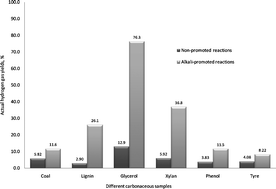Reaction of different carbonaceous materials in alkaline hydrothermal media for hydrogen gas production†
Abstract
Reactions of different carbonaceous materials in alkaline hydrothermal media have been studied in a batch reactor. In general,

* Corresponding authors
a
Energy and Resources Research Institute, School of Process, Environmental and Materials Engineering, The University of Leeds, UK
E-mail:
J.A.Onwudili@leeds.ac.uk
Fax: +44 113 246 7310
Tel: +44 113 343 2353
Reactions of different carbonaceous materials in alkaline hydrothermal media have been studied in a batch reactor. In general,

 Please wait while we load your content...
Something went wrong. Try again?
Please wait while we load your content...
Something went wrong. Try again?
J. A. Onwudili and P. T. Williams, Green Chem., 2011, 13, 2837 DOI: 10.1039/C1GC15204A
To request permission to reproduce material from this article, please go to the Copyright Clearance Center request page.
If you are an author contributing to an RSC publication, you do not need to request permission provided correct acknowledgement is given.
If you are the author of this article, you do not need to request permission to reproduce figures and diagrams provided correct acknowledgement is given. If you want to reproduce the whole article in a third-party publication (excluding your thesis/dissertation for which permission is not required) please go to the Copyright Clearance Center request page.
Read more about how to correctly acknowledge RSC content.
 Fetching data from CrossRef.
Fetching data from CrossRef.
This may take some time to load.
Loading related content
